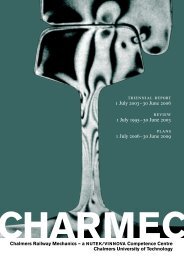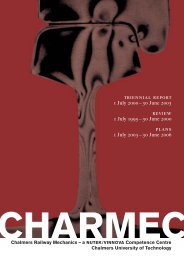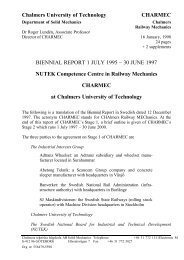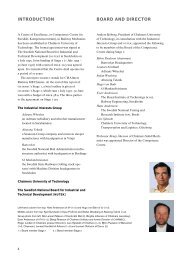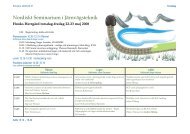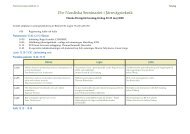stage 6 triennial report 1 July 2009–30 June 2012 ... - CHARMEC
stage 6 triennial report 1 July 2009–30 June 2012 ... - CHARMEC
stage 6 triennial report 1 July 2009–30 June 2012 ... - CHARMEC
You also want an ePaper? Increase the reach of your titles
YUMPU automatically turns print PDFs into web optimized ePapers that Google loves.
Vibrations and noise – Vibrationer och buller (VB) – Schwingungen und Geräusche – Vibrations et bruit<br />
VB11. ABATEMENT OF CURVE SQUEAL NOISE FROM TRAINS<br />
Reduktion av kurvskrikljud från tåg<br />
Verminderung des Quitschens von Zûgen in Kurven<br />
Réduction du grincement ferroviaire dans les courbes<br />
Project leaders Professor Wolfgang Kropp and<br />
and supervisors Dr Astrid Pieringer,<br />
Civil and Environmental<br />
Engineering/<br />
Division of Applied Acoustics<br />
Doctoral candidate Mr Ragnar Vidarsson, MSc<br />
(2011-01-15 – 2011-06-30)<br />
Mr Ivan Zenzerovic, MSc<br />
(from <strong>2012</strong>-06-01)<br />
Period 2011-01-01 – <strong>2012</strong>-06-30<br />
(– 2017-05-31)<br />
Chalmers budget Stage 6: ksek 1200<br />
(excluding university Stage 7: ksek 2 775<br />
basic resources)<br />
Industrial interests Stage 6: ksek 200<br />
in-kind budget Stage 7: ksek 200<br />
(Bombardier Transportation)<br />
From the left: Dr Astrid Pieringer, Professor Wolfgang Kropp and<br />
PhD student Ivan Zenzerovic from projects VB10 and VB11<br />
Curve squeal is a highly disturbing tonal sound generated<br />
by railway cars, metros and trams when they negotiate a<br />
sharp curve. For curves with a radius of 200 m and below,<br />
curve squeal noise is common. In addition, such tight<br />
curves are situated mainly in urban areas where many<br />
people live close to the tracks, see photo on page 35. The<br />
noise is also a comfort issue for the passengers inside the<br />
vehicles.<br />
Curve squeal noise is commonly attributed to selfexcited<br />
vibrations of the railway wheel, which are induced<br />
either by stick/slip behaviour due to lateral creepage of<br />
the wheel tyre on the top of the rail or by contact on the<br />
wheel flange. Practical solutions to reduce the noise have<br />
been wheel damping and friction modifiers. However, it<br />
38<br />
is desirable to gain a fundamental understanding of the<br />
mechanisms and causes of the squeal in order to find, if<br />
possible, appropriate vehicle and track designs to avoid<br />
or abate the generation of squeal noise. It should then be<br />
possible to predict not only the likelihood of noise but also<br />
its amplitude.<br />
Project vb11 will be divided into four parts: (i) a further<br />
extension of the time-domain model developed in project<br />
vb10, (ii) an experimental validation of the model, (iii) an<br />
extensive study to identify the essential parameters (and<br />
their complex interaction) responsible for curve squeal,<br />
and (iv) an investigation of the potential to reduce curve<br />
squeal by design changes to track and wheel. Like project<br />
vb10, this project is also being run in co-operation with<br />
project ts11.<br />
A measurement campaign on the sl line at Alvik – Stora<br />
Mossen in Stockholm has been run, and included measurements<br />
of both noise and vibration (vertical and lateral accelerations<br />
of the inner rail on a curve). The average speed<br />
of the accelerating trains was in the order of 20 km/h. The<br />
maxima in the spectrograms were compared<br />
with the frequencies of the wheel’s axial eigenmodes,<br />
which are often the cause of the squealing,<br />
and in certain cases a good agreement was<br />
found. Acceleration signals with a strong sawtooth<br />
shape were observed, possibly indicating<br />
stick/slip or flange climbing.<br />
As part of the preparatory work for project<br />
vb11, the model for the prediction of squeal<br />
noise developed in project vb10 was extended<br />
so that it now contains the whole chain from<br />
time-domain calculation of contact forces<br />
between wheel and rail, over wheel vibration,<br />
to radiated sound from the wheel. A Boundary Element<br />
Model (bem) of the wheel has also been set up and tested<br />
with an in-house bem code. This model was found to be<br />
computationally very costly. However, this can be compensated<br />
for by an approach where transfer functions from<br />
point forces on the wheel (radial and tangential) to the<br />
complex sound pressure at reference points in the field are<br />
precalculated. Based on these transfer functions, the sound<br />
field radiated from a vibrating wheel can be simulated very<br />
efficiently.<br />
The reference group for project vb11 has members from<br />
Bombardier Transportation (in Germany, Sweden and<br />
Switzerland), Interfleet Technology, sl and Trafikverket.<br />
The research plan for the project is dated 2010-05-15. The<br />
work has been delayed by the resignation of the original<br />
doctoral candidate and the recruitment of his successor.



